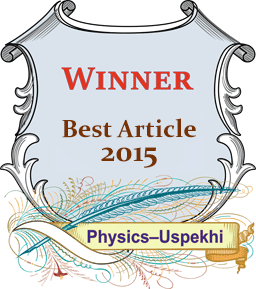 |
RSS feeds |
|
|||||
| Issue 12, 2025 |
|
||||||
|
|
|
||||||
Issues/2015/August |
← → |
| Physics of our days |
Physical laboratory at the center of the Galaxy
a Institute for Nuclear Research, Russian Academy of Sciences, prosp. 60-letiya Oktyabrya 7a, Moscow, 117312, Russian Federation
b National Research Nuclear University ‘MEPhI’, Kashirskoe shosse 31, Moscow, 115409, Russian Federation

This paper reviews the physical processes that occur at the center of the Galaxy and are related to the supermassive black hole SgrA* residing there. The discovery of high-velocity S0 stars orbiting SgrA* allowed for the first time the measurement of the mass of this our closest supermassive black hole with the 10% accuracy, with the result: Mh=(4,1±0,4) ✕ 106 M⊙. Further monitoring can potentially discover the Newtonian precession of the S0 star orbits in the gravitational field of the black hole due to the invisible distributed matter. This will yield the "weight" of the elusive dark matter concentrated there and provide new information for the identification of dark matter particles. The weak accretion activity of the "dormant quasar" at the Galactic center occasionally shows up as quasiperiodic X-ray and near IR oscillations with mean periods of 11 and 19 min, oscillations which can possibly be interpreted as related to the rotation frequency of the SgrA* event horizon and to the latitude oscillations of hot plasma spots in the accretion disk. Both these frequencies depend only on the black hole gravitational field and not on the accretion model. Using this interpretation yields quite accurate values both for the mass Mh and spin a (the Kerr rotation parameter) of SgrA*: Mh =(4,2±0,2) ✕ 106 M⊙ and a=0,65±0,05.
|
Keywords: black holes, Galactic center, dark matter
PACS: 95.35.+d, 97.60.Lf, 98.35.Gi, 98.35.Jk () DOI: URL: https://ufn.ru/en/articles/2015/8/c/  000364717300003 000364717300003  2-s2.0-84947750274 2-s2.0-84947750274  2015PhyU...58..772D 2015PhyU...58..772D Citation: Dokuchaev V I, Eroshenko Yu N "Physical laboratory at the center of the Galaxy" Phys. Usp. 58 772–784 (2015) Received: 30th, May 2015, accepted: 9th, June 2015 Оригинал: Докучаев В И, Ерошенко Ю Н «Физическая лаборатория в центре Галактики» УФН 185 829–843 (2015); |
|
© 1918–2025 Uspekhi Fizicheskikh Nauk Email: ufn@ufn.ru Editorial office contacts About the journal Terms and conditions |